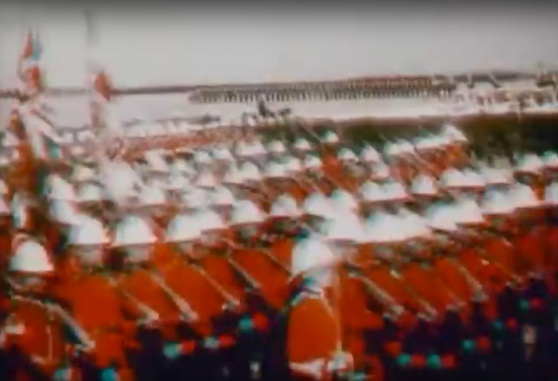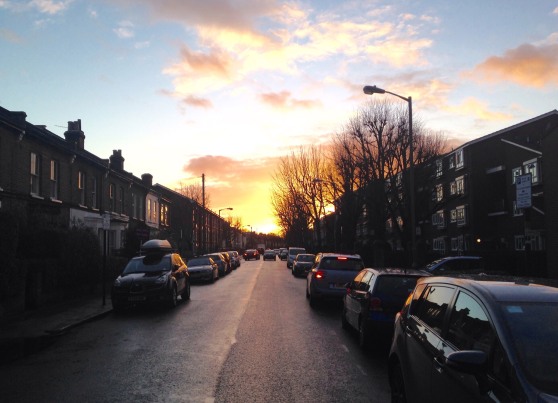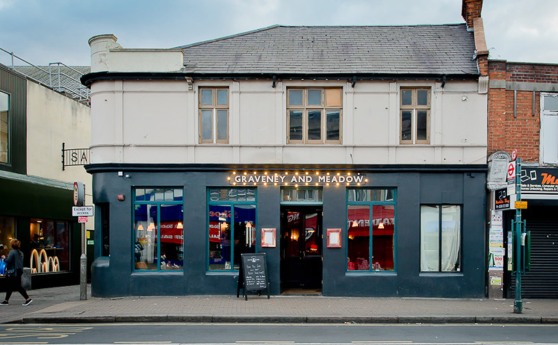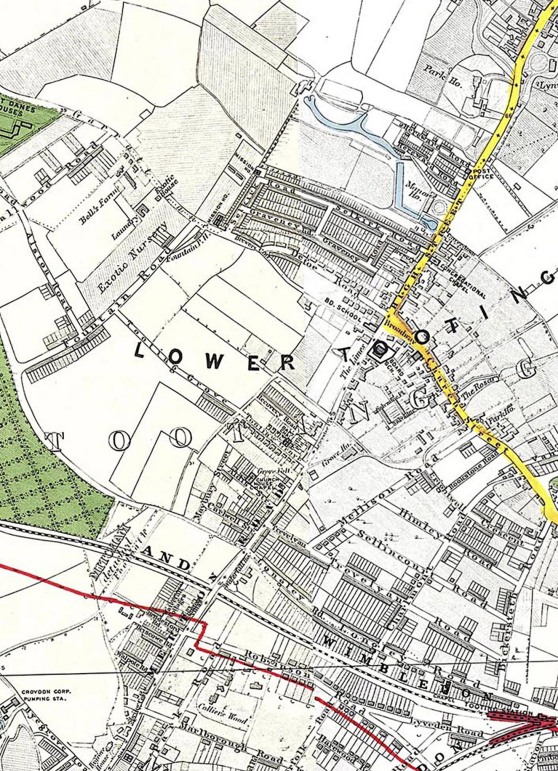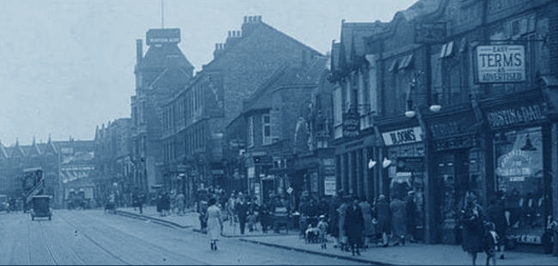



The 1911 census showed the Leicester family living at 48 Wimbledon Road on the corner of Keble Street, next door to St Mary’s Church. There was no sign of Arthur, the eldest of their eight children. He was in fact, a long way from home, with the Middlesex Regiment in India, one of 20,000 British troops involved in a massive show of colonial power. This was a big year for the ‘Jewel in the Crown’ with King George V in town on a five week tour from Bombay to Calcutta to Delhi. A whirl of cermonies and cocktail parties, playing polo with the Maharajas and shooting tigers from the top of an elephant. The main event on 7th December was the extravagent ‘Delhi Durbar’ an opulent assembly of some 250,000 people. Just a few weeks earlier Edward VII’s statue was unveiled in Tooting, now his son and Queen Mary were enthroned as King Emperor and Queen Empress of India. The British Empire had never seemed any grander. The Durbar was the first major news story for the fledgling film industry and one of the first events recorded in colour. One of those massed ranks marching past in their scarlet tunics may have been Arthur Leicester. Three years later he went to France and fought through until the final year of the First World War. On 3rd June 1918 he succumbed to his wounds in a hospital in Rouen. He is buried there in St Sever Cemetery Extension.


The great city of Rouen, capital of Normandy, stands on a huge bend in the Seine. Perhaps best known for Claude Monet and his numerous portraits of the catherdral, it is a city steeped in English medieval history. William the Conqueror often held court there, Richard the Lionheart was crowned Duke of Normandy in the town and left his heart there, quite literally. Joan of Arc, inspired a series of successes against the English army in the second half of the Hundred Years War between England and France. She was tried for heresy and ended up on a funeral pyre in Rouen in 1431. Throw in further devastation through fire and plague, not to mention Allied bombing raids during the Second World War and its safe to say the city has had a turbulent history.


Not far outside Rouen is what was once known as L’abbaye Notre-Dame du Bec in the tiny village of Hellouin. It was founded in 1034 by Herluin, a Norman knight who left military service in 1031 in order to commit himself to a life of religious devotion. Very quickly it became a centre of eleventh century ecclesiastical life and several of the early Abbots went on to become Archbishop of Canterbury, including the Italian-born Anselm, from 1093 to 1109. William the Conqueror invaded England in 1066 and enriched the abbey with extensive properties in England including the village that became known as ‘Tooting Bec’. Anselm reputedly visited the area before he became Archbishop and his name also lives on, in the large Roman Catholic Church opposite the tube station. Tooting Bec appears in the Domesday Book of 1086 as ‘Totinges’. Canonised shortly after his death, there’s a relief sculpture of Saint Anselm visiting the Totinges tribe on the exterior of Wandsworth Town Hall. Spare him a thought on 21st April, St Anselm’s Feast Day.



Back in France, during the Hundred Years War, the English army attacked and pillaged the abbey in 1418. Much restoration was done over the next century only for it to be damaged again during the Wars of Religion. It was left a ruin in the 1792 French Revolution but the 15th-century Tour Saint-Nicolas from the medieval monastery still stands. The monks departed and the abbey was occupied by the army until the Second World War. In 1948 monastic life was restored by a community of Benedictine monks.

Arthur Leicester grew up in south west London and went to France, probably for the first time in November 1914. He had another war on his mind and medieval monasteries were probably not on his radar. Far from the front line, Rouen was an extensive hospital centre with at least twenty hospitals based there for practically the entirity of the war. He has some local company in St Sever Cemetery. Also buried there are another of the Summerstown182, William Darvill from Hazelhurst Road and a Voluntary Aid Detachment nurse from Elmbourne Road called Mary Cawston Bousfield. Her name is on the war memorial in Holy Trinity Church, Tooting Bec. She died of pneumonia, following influenza, contracted on duty at 8th General Hospital in Rouen on 24th February 1919. She had been there from 1916 so might well have treated Arthur Leicester,
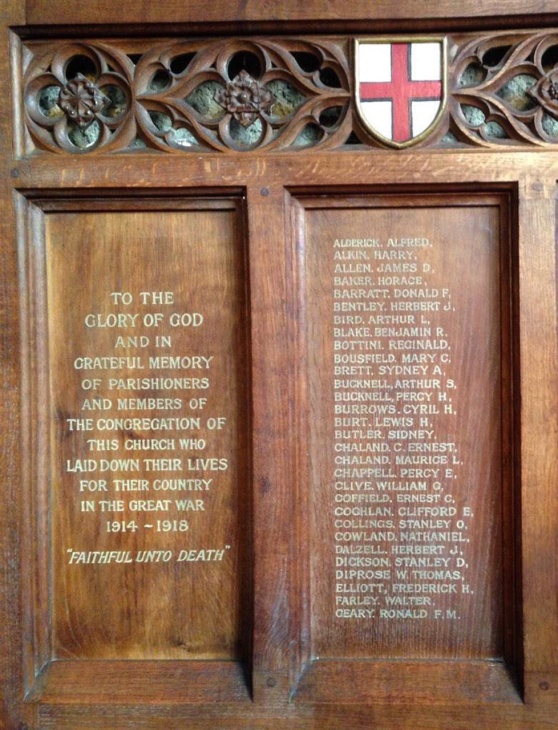

Arthur’s father was born Alfred Leicester in Kensington in 1870, but seems to have been known as Arthur. He married Agnes Mary Darling at St Faith’s Wandsworth in 1888. Arthur Henry Leicester was the oldest of their ten children, born in July 1889 at 100 Kamballa Road. Battersea seemed to be the family base and in the 1891 census they were living at 23 Harroway Road, near Prices Candle Factory. Alfred/Arthur was a labourer and riveter, working in the nearby railway yards. It seems they moved frequently, living also at Musjid Road and Afghan Road. In that 1891 census Arthur was two and his sister Alice was five months old. She died a few months later. Alfred and Agnes had seven boys and three girls; Arthur born 1889, Alice 1891, Charles 1892, Agnes 1896, Alfred 1897, Bertie 1899, Thomas 1902, Valentine 1905, a second Alice in 1909 and Harold 1912. Charles who lived for a long time in Alston Road died in 1973 aged 81, Harold in 1988 aged 76, Alice in 1990 aged 81 and Thomas in 2002 aged 100. He had worked in the twenties as a stoker at the Dust Destructor and lived on Foss Road.

By the 1901 census, the family were at 52 Musjid Road, a network of Battersea streets names after places associated with the Second Afghan War and dubbed ‘Little India’. Arthur was eleven and would have had little idea that one day he might visit these places. Four of his siblings are on the census, oddly all initialised rather than indicated with a full name. This road still stands though only six of the original houses have survived. Arthur and the other children probably attended Mantua Street School at the end of the road, now Falconbrook Primary. The following year Thomas was born at 52 Stewarts Road, on the Vauxhall side of Battersea. He died in Lewisham shortly after his one hundredth birthday. Three years later when Valentine was born they were living in Wandsworth. The 1911 census is interesting as the Leicesters were now at 48 Wimbledon Road, just across Keble Street from St Mary’s Church. Alfred, now using the name Arthur on his census form was forty and apparently working as a blacksmith for the City Corporation. He and Agnes had been married 22 years and its indicated that they had nine children, two, Alice and Alfred having died. Six of them were present on the census, Charles eighteen working as a carman for a laundry. Arthur is on another census record, a military one containing the names of thousands of men stationed in India. Over the next few years an Arthur Leicester appears in the local electoral rolls, living variously at 12 Bertal Road, 25 Summerstown and 21 Khartoum Road. Whether this was Arthur Henry or his parents, we can’t be sure. From 1915 though its clear that Arthur/Alfred and Agnes were resident at 116 Smallwood Road and were there until 1939. He died in 1942, Agnes ten years later. Again this was a house very close to a school and again their home no longer exists. An ‘A Leicester, 2nd Middlesex’ is indicated in the Smallwood School Roll of Honour’ suggesting he attended there. Odd though that there is no mention here or in the Absent Voters lists of any of his brothers involvement and Charles, Bertie, possibly Thomas would all have been liable for war service.


The 1st Battalion of the Middlesex Regiment were in India and thereabouts from 1899 and moved to Aden in 1912 before returning to Britain in 1913. Arthur Leicester was a hardened soldier who had seen something of the world, certainly not a fresh-faced volunteer plucked from civvy street. His medal card indicates that come the First World War, he entered France on 7th November 1914. He was in the 2nd Middlesex Regiment at that stage and if he was still with them in the summer of 1916 he would have been lucky to survive the fearsome first days of the Somme. At some stage he transfered to the 8th Battalion Loyal North Lancashire Regiment and then to the 2/4th. He was with them when he died of his wounds on 3rd June 1918. There are no clues on his soldiers effects records as to where this happened but its likely he was taken to one of the hospitals in Rouen, far behind the lines. Here he died and was buried in St Sever Cemetery Extension. There is no mention of him being in the army in the St Mary’s Church parish magazine over the course of the war but his death is noted in the November issue in the same paragraph as William Darvill who was killed the previous month.


Just a few miles from St Anselm’s Church at Tooting Bec, down the A24, once the great Roman road of Stane Street, , was the extraordinary Merton Priory. This remarkable establishment was believed to be once supplied with corn, ground at a mill in Summerstown. It was founded in 1114 and destroyed in 1538 by Henry VIII. The priory became an important centre of learning, attended by Thomas Becket in 1130 and Nicholas Breakspeare who went on to become Adrian IV, the first English Pope, in 1154. King Henry III held a Parliament here in 1236. Traces of it can amazingly still be found amidst the ugly commercial mess dominated by the Sainsbury’s superstore complex and its attendant millenial retail developments. Currently the diggers are at work in the car-park next to the Merton Abbey Mills site and there are plans afoot to make the Chapeter House foundations under Merantum Way more accessible.



Just across the road from St Anselm’s Church at Tooting Bec is an eclectically furnished cocktail bar/eaterie called The Imperial Durbar. If you get a chance, do pop into this quirky establishment and raise your chai or gin sling to a Tooting soldier who one hundred years ago sweated in his scarlet tunic among a quarter of a million people in the Delhi heat as King George V, the Maharajas, the elephants and the camels went past. Indeed perhaps think of this establishment as our very own Tooting tribute to Arthur Henry Leicester from Smallwood Road.
